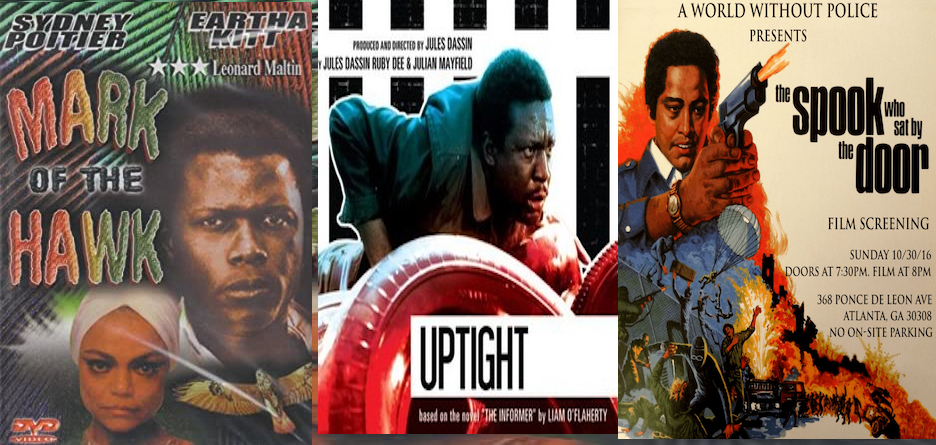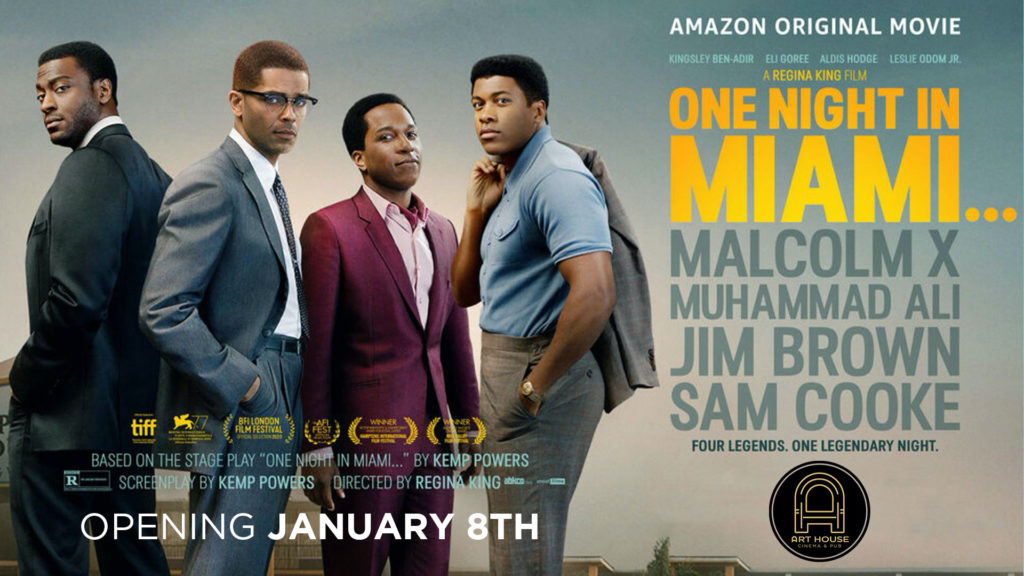
Fred Hampton speaks at a Chicago Black Panther Rally in 1969
For more than 70 years and over a century, respectively, television and cinema have presented demeaning images of Black people. And for equally as long, African Americans have responded with boycotts, pickets and alternative visions that “depict[ed] our men and women in a favorable light and as they really are,” as Lester Walton, the arts critic for the African American newspaper the New York Age, put it in 1920.¹ Yet compared to the thousands of degrading representations, positive depictions of Black folk on the small or big screen were admittedly few during the 20th century. In the new millennium, as African American writers and directors have gotten more projects greenlighted, Black films have become more diverse in subject and characterization. One Night in Miami and Judas and the Black Messiah stand at the apex of a two-decade-long trend in which African American stories and characters have become less stereotypical and more complex and realistic.
Nonetheless, outside the documentary genre, only Selma (2014) presents movement activists as protagonists. And it carefully distinguishes between the so-called “responsible Negro leaders” and irresponsible “militants.” As Julian Bond notes, Selma provides an “awful depiction” of Student Non-Violent Coordinating Committee Executive Director James Forman Sr., a militant. Though Forman was older than Dr. King, in the film “he’s treated as a youngster,” and portrayed as a disrespectful “kid with a hot temper.”²

Among the few US films which have depicted militant or revolutionary Black protagonists, Sidney Poitier’s Mark of the Hawk (1957) and the Blaxploitation era films Uptight (1968) and The Spook Who Sat by the Door (1973) stand out. One Night in Miami and Judas and the Black Messiah also locate the relationships, struggles and ideas of Black militants and revolutionaries at the heart of the story. Both films present militant activists and revolutionaries as rational, thoughtful and compassionate.

One Night in Miami’s director Regina King calls it “a love letter to the black man’s experience.”
She describes Miami as a “layered” narrative in which Malcom X, Cassius Clay, Sam Cooke and Jim Brown “are vulnerable, they are strong, they are providers, they are sometimes putting on a mask. They are not unbreakable. They are flawed.”³
The effort to humanize the men mostly works. You can feel the pressure on Malcolm X as he frets over life under constant FBI surveillance and his impending post–Nation of Islam (NOI) future. Yet I don’t recognize this Malcolm X. He does not conform to anyone’s recollection. Only in this fictitious world does Malcolm X demonstrate so little self-control.
Both films carry the ominous “based on” or “inspired by a true story” tagline. Of the two, Miami most departs from history. It is screenwriter Kemp Powers’s fictional account of the conversations between the four men. Powers and King distort the chronology in which the events occurred. For instance, the incident between Jim Brown and an erstwhile white benefactor and admirer occurred five years before the first Clay-Liston fight, not on the eve of it. Also, there were several other people, mainly members of the NOI, in Malcolm X’s room at the Hampton House Hotel that night. Nonetheless, much of the “dramatic license” taken by Powers and King is acceptable.
What’s unacceptable is the contrived debate between Kingsley Ben-Adair’s Malcolm X and Leslie Odom Jr.’s Sam Cooke. Powers and King mistakenly perceive the greatest ideological and political differences as between Malcolm X and Cooke. In doing so, they severely misrepresent Cooke. The only actual report of the night’s conversation comes from Cooke’s friend, DJ William “Rosko” Mercer, who shortly thereafter said Cooke told him he was interested in the NOI and considered African Americans “victims” of “colonial oppression.”4
All four men were militants, meaning they were willing to fight for their beliefs. However, Clay, who had been a member of the NOI for more than a year before the fight, and Malcolm X were Black nationalists. But so was Cooke.
Unlike his entertainment peers, Cooke was knowledgeable about African and African American history and read contemporary authors like James Baldwin. He resented performing before apartheid audiences and once organized Black performers to boycott such venues. And when everyone else backed down, he alone refused to perform. As early as 1958, a decade before the afro became a popular hairstyle, he wore his hair natural. Explaining his reasoning, Cooke declared “I don’t want to try to look like somebody else, I’m proud of being myself, I’m proud of who I am, I’m proud of my race.”5 Additionally, he convinced a generation of Black male singers to forgo their processes and go natural.

Whereas Powers and King chose fiction, Shaka King, director of Judas and the Black Messiah, opted mostly for historical accuracy. His title is inspired by the second objective of the FBI’s COINTELPRO program, to “Prevent the rise of a ‘messiah’ who could unify, and electrify, the militant black nationalist movement” (emphasis mine). King makes excellent use of historical footage of Black Power activists and especially of FBI informant William O’Neal’s disturbing Eyes on the Prize interview. Most important, he presents Chicago Black Panther Party (BPP) Chairman Fred Hampton as the brilliant, dedicated, sensitive and considerate revolutionary that he was.
In showing the Panthers striving to build a Black united front, organizing the “rainbow coalition” and operating numerous “Service to the People” programs, King subtlety counters the FBI’s claims that the BPP was an organization of racist violence-prone extremists.
Like Miami, the acting in Black Messiah is outstanding. Daniel Kaluuya and LaKeith Stanfield are superb in their roles. That Kaluuya won the Oscar for Best Supporting Actor and beat out co-star Stanfield reveals both the movie’s strength and its central weakness. As the title suggests, William O’Neal—Judas—occupies the titular role. He is the protagonist. He transforms from a simple juvenile street criminal into a sophisticated adult informant. Meanwhile Fred is introduced as a fully developed character. All the suspenseful moments concern O’Neal. Perhaps King was intrigued by previous films that focused on informants, such as The Informer (1935), On the Waterfront (1954) or Uptight (1968). Whatever King’s motivations, it was a horrible decision.
It meant truncating Hampton’s life and presenting the Chicago BPP outside the context of the national party. We learn nothing of Chairman Fred’s upbringing: why did he gravitate from the NAACP to the BPP? The film is too narrowly focused. Messiah implies the state’s insidious and murderous machinations were solely J. Edgar Hoover’s. Even though he is not the film’s protagonist, Chairman Fred is depicted as an extraordinary individual, which he was—but he was also part of an exceptional cohort of young Panther leaders. When Hampton was assassinated in 1969, at age 21, Erika Huggins was also 21; Dhoruba bin-Wahad was 24; Assata Shakur and Elmer “Geronimo” Ji-Jaga Pratt were 20; Dr. Mutulu Shakur was 19; and my deceased comrade, Dr. Ahmad Rahman, was just 18. Hampton’s assassination was part of a coordinated national assault on the BPP and Black militants and revolutionaries around the country. The film minimizes this aspect.
While seriously flawed politically, both films are well made and wonderfully acted. By focusing on militants and revolutionaries both films inch us forward. The major virtue of Miami and Black Messiah are their humane portrayals of Black militants and revolutionaries.
Notes
- Quoted in Allyson Nadia Field, “Black Cinema at its Birth,” The Current, March 3, 2020.
- Douglass Blackmon, “Interview with Julian Bond,” American Forum, Miller Center, February 12, 2015.
- Harley Copen, “Interview with Regina King,” ICG Magazine, February 15, 2021; Jenna Marota, “2 Major Movies and a Life Shadowed by Pain and Perfectionism,” December 3, 2020, New York Times.
- Mike Marquesee, Redemption Song: Muhammad Ali and the Spirit of the Sixties (London: Verso, 2000), 99.
- Peter Guralnick, “How Sam Cooke Invented the Afro,” Dangerous Minds, October 27, 2014.
- Jon Greenberg, “Fact-checking ‘Judas and the Black Messiah’ the Film about the Killing of a Black Panther Leader,” Politifact, The Poynter Institute, April 14, 2021; J. Edgar Hoover, Director, FBI, “COUNTERINTELLIGENCE PROGRAM BLACK NATIONALIST HATE GROUPS RACIAL INTELLIGENCE,” March 4, 1968 Memo, Federal Bureau of Investigation, FBI Records, The Vault.

Sundiata Keita Cha-Jua is a Black/Africana Studies scholar-activist who uses historical methodologies. He teaches in the departments of African American Studies and History at UIUC. He has been engaged with local and national Black liberation movement organizations since his teen years; he is currently an organizer for the Malcolm X Grassroots Movement (MXGM).
919 total views, 1 views today